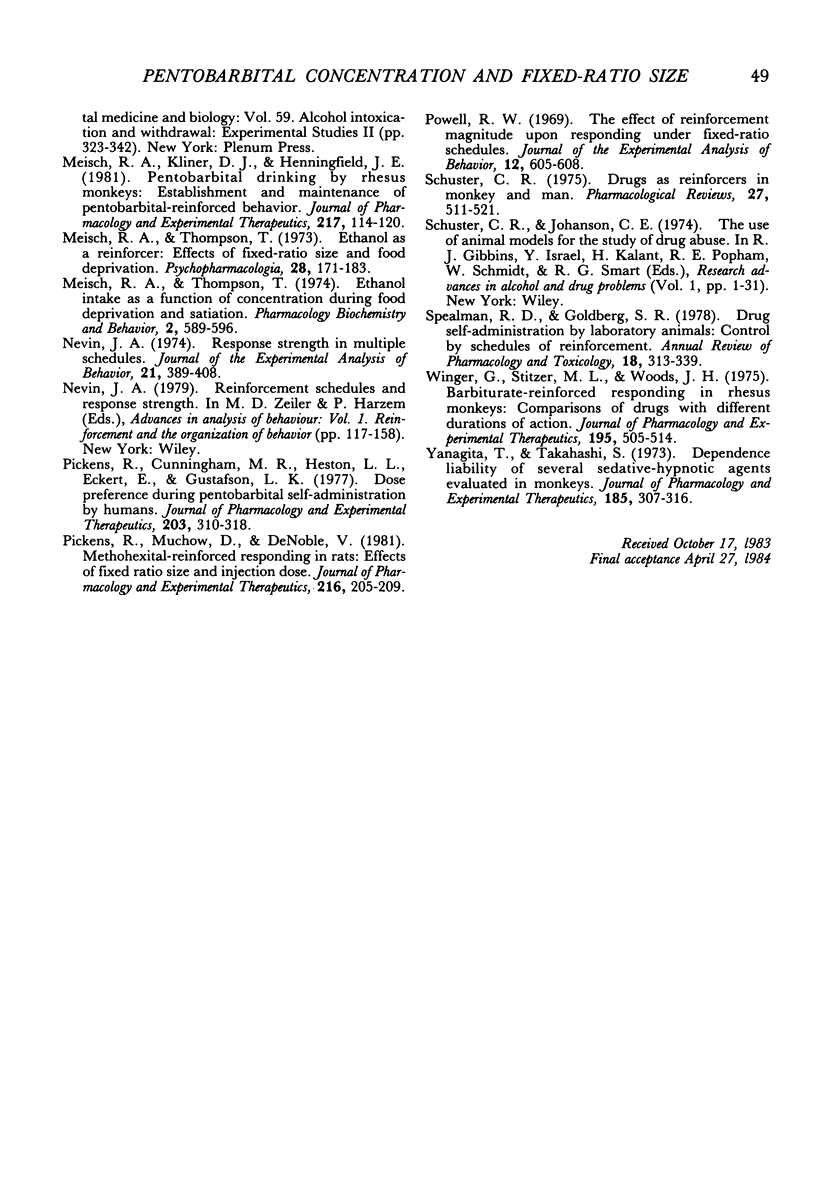Abstract
Performances of three rhesus monkeys were reinforced by the oral delivery of pentobarbital and studied as functions of fixed-ratio size and drug concentration. Pentobarbital solutions and water were concurrently available on identical reinforcement schedules from separate liquid-delivery systems during 3-hour sessions. Under a fixed-ratio 16 schedule of drug availability, a descending series of drug concentrations was tested (4, 2, 1, 0.5, 0.25, 0.125, and 0.0625 mg/ml, followed by a retest at 4 mg/ml). Partial concentration series beginning with the highest concentration were repeated with fixed-ratios of 32 and 64, with a fixed-ratio 128 for two monkeys, and with fixed-ratio 256 for one. At each fixed-ratio value, response rate and number of drug deliveries were inverted U-shaped functions of pentobarbital concentration. Drug intake (mg/kg/session) increased directly with drug concentration. As the fixed-ratio size was increased, the number of liquid deliveries decreased. For each drug concentration, when the numbers of drug deliveries at fixed-ratios of 32, 64, and 128 responses were plotted as percentages of those obtained at fixed-ratio 16, the following orderly relationship emerged: the higher the drug concentration, the less that drug deliveries were decreased by increases in fixed-ratio size. This relationship indicates an increase in reinforcing efficacy with increases in pentobarbital concentration.
Full text
PDF












Selected References
These references are in PubMed. This may not be the complete list of references from this article.
- Altshuler H., Weaver S., Phillips P. Intragastric self-administration of psychoactive drugs by the rhesus monkey. Life Sci. 1975 Sep 15;17(6):883–890. doi: 10.1016/0024-3205(75)90439-7. [DOI] [PubMed] [Google Scholar]
- Carroll M. E., Meisch R. A. Etonitazene as a reinforcer: oral intake of etonitazene by rhesus monkeys. Psychopharmacology (Berl) 1978 Dec 8;59(3):225–229. doi: 10.1007/BF00426626. [DOI] [PubMed] [Google Scholar]
- Carroll M. E., Meisch R. A. Oral phencyclidine (PCP) self-administration in rhesus monkeys: effects of feeding conditions. J Pharmacol Exp Ther. 1980 Aug;214(2):339–346. [PubMed] [Google Scholar]
- Carroll M. E., Meisch R. A. The effects of feeding conditions on drug-reinforced behavior: maintenance at reduced body weight versus availability of food. Psychopharmacology (Berl) 1980;68(2):121–124. doi: 10.1007/BF00432128. [DOI] [PubMed] [Google Scholar]
- DeNoble V. J., Svikis D. S., Meisch R. A. Orally delivered pentobarbital as a reinforcer for rhesus monkeys with concurrent access to water: effects of concentration, fixed-ratio size, and liquid positions. Pharmacol Biochem Behav. 1982 Jan;16(1):113–117. doi: 10.1016/0091-3057(82)90021-1. [DOI] [PubMed] [Google Scholar]
- Goldberg S. R., Hoffmeister F., Schlichting U. U., Wuttke W. A comparison of pentobarbital and cocaine self-administration in rhesus monkeys: effects of dose and fixed-ratio parameter. J Pharmacol Exp Ther. 1971 Nov;179(2):277–283. [PubMed] [Google Scholar]
- Griffiths R. R., Bigelow G., Liebson I. Human drug self-administration: double-blind comparison of pentobarbital, diazepam, chlorpromazine and placebo. J Pharmacol Exp Ther. 1979 Aug;210(2):301–310. [PubMed] [Google Scholar]
- Griffiths R. R., Brady J. V., Snell J. D. Progressive-ratio performance maintained by drug infusions: comparison of cocaine, diethylpropion, chlorphentermine, and fenfluramine. Psychopharmacology (Berl) 1978 Jan 31;56(1):5–13. doi: 10.1007/BF00571401. [DOI] [PubMed] [Google Scholar]
- Henningfield J. E., Meisch R. A. Drinking device for rhesus monkeys. Pharmacol Biochem Behav. 1976 May;4(5):609–610. doi: 10.1016/0091-3057(76)90204-5. [DOI] [PubMed] [Google Scholar]
- Henningfield J. E., Meisch R. A. Ethanol drinking by rhesus monkeys as a function of concentration. Psychopharmacology (Berl) 1978 Apr 28;57(2):133–136. doi: 10.1007/BF00426877. [DOI] [PubMed] [Google Scholar]
- Iglauer C., Woods J. H. Concurrent performances: reinforcement by different doses of intravenous cocaine in rhesus monkeys. J Exp Anal Behav. 1974 Jul;22(1):179–196. doi: 10.1901/jeab.1974.22-179. [DOI] [PMC free article] [PubMed] [Google Scholar]
- Johanson C. E. Behavior maintained under fixed-interval and second-order schedules of cocaine or pentobarbital in rhesus monkeys. J Pharmacol Exp Ther. 1982 May;221(2):384–393. [PubMed] [Google Scholar]
- Johanson C. E., Schuster C. R. A choice procedure for drug reinforcers: cocaine and methylphenidate in the rhesus monkey. J Pharmacol Exp Ther. 1975 May;193(2):676–688. [PubMed] [Google Scholar]
- Kliner D. J., Meisch R. A. The effects of food deprivation and satiation on oral pentobarbital self-administration in rhesus monkeys. Pharmacol Biochem Behav. 1982 Apr;16(4):579–584. doi: 10.1016/0091-3057(82)90419-1. [DOI] [PubMed] [Google Scholar]
- Meisch R. A., Kliner D. J., Henningfield J. E. Pentobarbital drinking by rhesus monkeys: establishment and maintenance of pentobarbital-reinforced behavior. J Pharmacol Exp Ther. 1981 Apr;217(1):114–120. [PubMed] [Google Scholar]
- Meisch R. A., Thompson T. Ethanol as a reinforcer: effects of fixed-ratio size and food deprivation. Psychopharmacologia. 1973 Jan 1;28(2):171–183. doi: 10.1007/BF00421402. [DOI] [PubMed] [Google Scholar]
- Meisch R. A., Thompson T. Ethanol intake as a function of concentration during food deprivation and satiation. Pharmacol Biochem Behav. 1974 Sep-Oct;2(5):589–596. doi: 10.1016/0091-3057(74)90025-2. [DOI] [PubMed] [Google Scholar]
- Nevin J. A. Response strength in multiple schedules. J Exp Anal Behav. 1974 May;21(3):389–408. doi: 10.1901/jeab.1974.21-389. [DOI] [PMC free article] [PubMed] [Google Scholar]
- Pickens R., Cunningham M. R., Heston L. L., Eckert E., Gustafson L. K. Dose preference during pentobarbital self-administration by humans. J Pharmacol Exp Ther. 1977 Nov;203(2):310–318. [PubMed] [Google Scholar]
- Pickens R., Muchow D., DeNoble V. Methohexital-reinforced responding in rats: effects of fixed ratio size and injection dose. J Pharmacol Exp Ther. 1981 Feb;216(2):205–209. [PubMed] [Google Scholar]
- Powell R. W. The effect of reinforcement magnitude upon responding under fixed-ratio schedules. J Exp Anal Behav. 1969 Jul;12(4):605–608. doi: 10.1901/jeab.1969.12-605. [DOI] [PMC free article] [PubMed] [Google Scholar]
- Schuster C. R. Drugs as reinforcers in monkey and man. Pharmacol Rev. 1975 Dec;27(4):551–521. [PubMed] [Google Scholar]
- Spealman R. D., Goldberg S. R. Drug self-administration by laboratory animals: control by schedules of reinforcement. Annu Rev Pharmacol Toxicol. 1978;18:313–339. doi: 10.1146/annurev.pa.18.040178.001525. [DOI] [PubMed] [Google Scholar]
- Winger G., Stitzer M. L., Woods J. H. Barbiturate-reinforced responding in rhesus monkeys: comparisons of drugs with different durations of action. J Pharmacol Exp Ther. 1975 Dec;195(3):505–514. [PubMed] [Google Scholar]
- Yanagita T., Takahashi S. Dependence liability of several sedative-hypnotic agents evaluated in monkeys. J Pharmacol Exp Ther. 1973 May;185(2):307–316. [PubMed] [Google Scholar]


